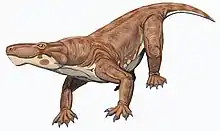Scylacosauridae
Scylacosauridae is an extinct family of therocephalian therapsids. Scylacosaurids lived during the Permian period and were among the most basal therocephalians.[1] The family was named by South African paleontologist Robert Broom in 1903.[2] Scylacosaurids have long snouts and unusual saber-like canine teeth.[3]
| Scylacosauridae | |
|---|---|
 | |
| Life restoration of Scylacosaurus | |
| Scientific classification | |
| Kingdom: | Animalia |
| Phylum: | Chordata |
| Clade: | Therapsida |
| Suborder: | †Therocephalia |
| Clade: | †Scylacosauria |
| Family: | †Scylacosauridae Broom, 1903 |
| Genera | |
|
†Alopecideops | |
References
- Huttenlocker, A. (2009). "An investigation into the cladistic relationships and monophyly of therocephalian therapsids (Amniota: Synapsida)". Zoological Journal of the Linnean Society. 157 (4): 865–891. doi:10.1111/j.1096-3642.2009.00538.x.
- Broom, R. (1903). "On the classification of the theriodonts and their allies". Report of the South African Association for the Advancement of Science. 1: 286–294.
- Valkenburgh, B. van; Jenkins, I. (2002). "Evolutionary patterns in the history of Permo-Triassic and Cenozoic synapsid predators" (PDF). In Kowalewski, M.; Kelley, P.H. (eds.). The Fossil Record of Predation. 8. Paleontological Society Special Publications. pp. 267–289. Archived from the original (PDF) on 2013-10-17.
This article is issued from Wikipedia. The text is licensed under Creative Commons - Attribution - Sharealike. Additional terms may apply for the media files.


